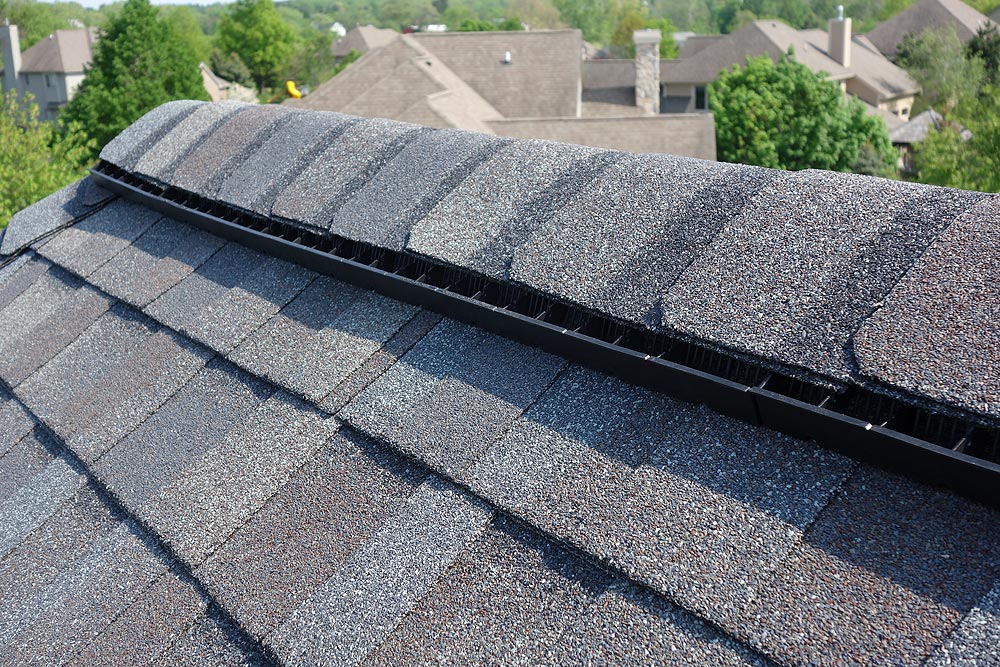
Correct attic ventilation protects your roof, your attic insulation, your heating/cooling bills and your family’s health. It plays a significant role in reducing heat and moisture in your attic – moisture that can lead to mold, mildew and bacteria growth. In addition it reduces the risk of ice dams, a threat to many Madison WI homes. Efficient ventilation means your air conditioner doesn’t have to work as hard this summer. That’s worth a few dollars off your energy bill.
Extending the life of your roof, protecting your investment and lowering costs are great reasons to make sure your attic is properly vented, right?
What do roof vents do? They simply promote a smooth exchange of fresh outdoor air with stale inside air. How they do it, though, isn’t always easy. Vents must be placed near the bottom of the attic space at sofits and eaves. These are the intake vents where fresh air comes in. Additional vents go on peaks and ridges to allow stale air to escape. A balanced system takes advantage of the fact that hot air rises. Vents in the right places, kept clean and free of debris allow air to flow freely. That means the temperature and humidity level in the attic are stable season to season. To work correctly, the system must be balance the rate of intake and exhaust.
Without efficient exhaust, hot air doesn’t escape. The system only works when intake matches exhaust.
How Much Attic Ventilation Is Enough?
On a typical summer day in southern Wisconsin temperatures often hit 90°. That means your attic temperature can reach 140° or higher. If this heated air cannot find a way out, it works its way into your living space. In winter, moist attic air seeps into your home where it causes mold or mildew to form inside walls and ceilings. Ventilation is the only remedy.
Do you have enough ventilation? Is it working as it should? Here are simple things to look for:
- Look under your eaves to see if you have attic vents. Are they clean – debris and pests often find their way into these vents. If you don’t see any, you need to add them.
- Do you have vents on the very top edge, ridge, of the roof? They’re low-profile and run the entire length of the roof. These are the prime exhaust vents.
- Are there additional vents placed at elsewhere on the roof? Some roofs have different requirements and there are many styles used today.
Next, there are inspections to do indoors: - In a room nearest the roof, touch the ceiling on a warm, sunny day. Is it hotter than normal? If it is the attic has become a solar oven – baking your shingles and toasting your cooling bills.
- Take a close look inside the attic on a cold day. Can you see frost or damp areas? Is the evidence of mold or mildew?
In winter, ridges of ice near eaves is a sign that warm air from inside the house is trapped in the attic causing snow to melt and refreeze. Dampness on insulation and structured inside the attic mean the same thing.
Maintaining A Healthy Roof

“But, I have plenty of insulation, doesn’t that make a difference?”
Your insulation might be contributing to the problem. Attic insulation pushed too far down between rafters can plug vent areas and restrict airflow around soffit and roof vents. Insulation is an essential ingredient in a healthy roof and home but not the answer to every concern.
Without adequate ventilation moisture building in the attic causes roof decking to swell, rot and buckle. It doesn’t hold nails and is weak. In winter if forms ice. That’s particularly dangerous because when water freezes it expands, pushing roofing materials apart, allowing even more water in. Unchecked it leads to leaks in walls and ceilings.
All year around condensation also creates perfect conditions for mold and mildew – threats to allergy sufferers and overall indoor air quality.
Are these reasons enough to take proper ventilation in your attic seriously? They are. And, the good news is there are solutions. Poor ventilation today doesn’t mean you must replace the roof right away. There are ways professional roofing contractors can step in to protect your investment and your family. The first step is a professional roof inspection.
An Rx For Improving Attic Ventilation
You’ve done the simple checks mentioned here and have questions, right? You’re probably asking:
- How many vents is enough?
- My roof has many peaks and angles, where do vents need to be?
- What kind of vent is best for my roof?
- Are there different sizes, shapes?
National and local building codes will help decide how many vents are appropriate for your roof, but they’re complicated for homeowners to decipher. Sims Exteriors & Remodeling’s roofing specialists, working with one of the leading roofing materials suppliers offer a ventilation calculator to help sort out what you need.
If you have concerns for the health of your roof call us for a detailed inspection. We’ll review all your concerns and suggest appropriate options. No roofing contractor has more experience in the Madison area than Sims Exteriors & Remodeling. We have decades of experience installing siding, roofing and windows in the Madison area. Call 608-825-4500, or email us for an evaluation of the attic ventilation in your Madison WI home.

